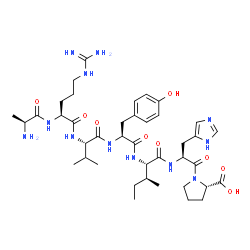| Description |
Alamandine, a member of the renin-angiotensin system (RAS), a vasoactive peptide, is an endogenous ligand of the G protein-coupled receptor MrgD. Alamandine targets to protect the kidney and heart through anti-hypertensive actions[1][2].
|
| Related Catalog |
|
| In Vitro |
Alamandine is generated by catalysis of Ang A via ACE2 or directly from Angiotensin 1-7 (Ang-(1-7)). Derived from angiotensin II (Ang II) by Ang II-converting enzyme 2 (ACE2), it shows vasodilating (thus protective) properties. Ang (1-7) can be decarboxylated to a peptide called Alamandine. Alamandine is also an endogenous peptide identified in human blood[1]. Alamandine elevates cAMP concentration in primary endothelial and mesangial cells, also suggesting Gs coupling[2]. Alamandine decreases secretion, expression, and blood levels of leptin. Alamandine induced expression of iNOS and plasminogen activator inhibitor-1 (PAI-1) in adipose tissue and isolated adipocytes[2].
|
| In Vivo |
Alamandine (0.15 μL/h; administered by mini-osmotic pumps; for 6 weeks) treatment ameliorates hypertension and impaires left ventricle (LV) function in SHRs. Also decreases the mass gains of heart and lung in SHRs, suppresses cardiomyocyte cross-sectional area expansion, and inhibits the mRNA levels of atrial natriuretic peptide and brain natriuretic peptide[3]. Animal Model: Male spontaneously hypertensive rats (SHRs, 50-week-old)[3] Dosage: 0.15 μL/h (~50 μg/kg/day) Administration: Administered by mini-osmotic pumps; for 6 weeks Result: Attenuated hypertension, alleviated cardiac hypertrophy, and improved LV function.
|
| References |
[1]. Daniel C Villela, et al. Alamandine: a new member of the angiotensin family. Curr Opin Nephrol Hypertens. 2014 Mar;23(2):130-4. [2]. Johanna Schleifenbaum. Alamandine and Its Receptor MrgD Pair Up to Join the Protective Arm of the Renin-Angiotensin System. Front Med (Lausanne). 2019 Jun 11;6:107. [3]. Chi Liu, et al. Alamandine attenuates hypertension and cardiac hypertrophy in hypertensive rats. Amino Acids. 2018 Aug;50(8):1071-1081.
|
